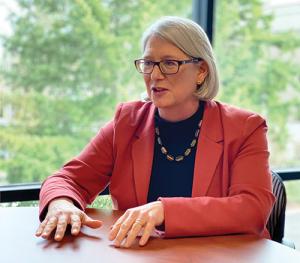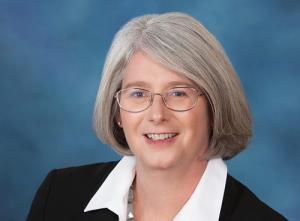NARUC
Washington Utilities and Transportation Commissioner Ann Rendahl is an Executive Committee Member and Electricity Committee Past Chair of the National Association of Regulatory Utility Commissioners. Paul Kjellander is Senior Advisor at Public Utilities Fortnightly.
So much is going on in the energy and utilities industry out west that it seems impossible to keep up with it all. In an attempt to do that, the PUF team homed in on a Commissioner who is tough to track down, because she is everywhere, learning and doing in the public interest.

If you want to find out what is going on out west, you need to talk to Washington Utilities and Transportation Commissioner Ann Rendahl. That is because the region is considerably large, and it takes a ton of knowledge to understand all about it.
Washington State UTC, NARUC, the Body of State Regulators for the California ISO's Energy Imbalance Market, EPRI's Advisory Council, New Mexico State U's Center for Public Utilities are just some of the organizations that have benefited from her expertise. PUF's Paul Kjellander sat down with Commissioner Ann Rendahl and discussed the plethora of energy initiatives in the west she is engaged with. Enjoy.
PUF's Paul Kjellander: When I think of Commissioners who are active on power issues in the west, your name always comes to the top of the list. Is there any major effort there you aren't involved with?
Ann Rendahl: Given the number of efforts underway in the west, in multiple ways, I feel like I'm dipping my toe in the water. There are a number of amazing leaders of Commissions in the west who are making the effort. I'm not the only one.
 Ann Rendahl: With the Western Resource Adequacy Program, we need to get it off the ground and successfully implemented to address the resource adequacy issues. But having a day-ahead market of some form, it’s going to happen.
Ann Rendahl: With the Western Resource Adequacy Program, we need to get it off the ground and successfully implemented to address the resource adequacy issues. But having a day-ahead market of some form, it’s going to happen.
I'm engaged, but others are also engaged in the Energy Imbalance Market, the Western Resource Adequacy Program, the Extended Day-Ahead Market conversations, the Markets Plus Initiative, and the NorthernGrid transmission planning organization.
There's a lot of engagement with western Commissioners and energy office staff. It's a great time to be doing this because there're a lot of people interested and involved in it.
PUF: You're at the cutting edge as you start to look at those things and how they're evolving in the west.
Ann Rendahl: It's exciting. It's hard to believe it's only been seven years since I started really engaging in this, so there's been a lot of movement. While there has been a lot of turnover in Commissioners, there's a lot of engagement. It feels good to be spending time talking about these issues.
PUF: Before we jump into what you see as the future and ask you to pull out a crystal ball of sorts, how would you describe the current state of electricity and power concerns as it relates to the west?
Ann Rendahl: There is a lot going on. As many issues as there are states and utilities in the west, there're a lot of issues in different regions.
The most critical issue right now is resource adequacy and making sure that in every state and for every utility, whether they're a public utility or investor-owned utility, that there is sufficient power, sufficient energy, because it could be both through demand response or actual physical capacity energy from generation, to get us through some of the difficult times.
That's whether it's the heat and the drought that's going on this summer and in past summers, or the cold, to get us through the cold and the dark with this important transition of energy that we're going through and how we can do so reliably. That's one of the critical issues.
The other most recently now, because of COVID and the geopolitical issues going on with Ukraine is supply chain. Supply chain is a big problem and how we're going to be able to build the new energy facilities, whether it's wind, solar, electric vehicle charging stations, and even nuclear. It's just basic steel in the ground too.
How are we going to get access to all of this, with the supply chain affecting both materials and the time it takes to get these built? And let's not forget labor and the difficulties finding people for the building trades. There are a lot of headwinds right now.
We've got the importance of the transformation and then we have the headwinds that are making it more difficult. But it's resource adequacy, supply chain headwinds, and also market development. Those are the key issues going on in the west, regardless of whether you're a state with clean-energy policies or not.
PUF: About fourteen states are part of the Western Interconnection and they're diverse geographically, politically, and in resources used to provide power. The Western Interconnection is the largest in North America. How difficult does that make it in trying to plan for the future?
Ann Rendahl: Diversity can be a challenge and an opportunity. Frankly, because it's a big place with lots of types of resources, the benefit of the market is that, for trading across the west, you can benefit from different time zones and diversity of resources, when wind comes on, or solar comes on, or where you have gas plants operating or nuclear, and let's not forget hydro.
That's huge. The benefit of having a diversity of resources that might be generating at different times, is both an opportunity and benefit for the west.
The challenge is having significant resources coming offline, or the drought in the southwest and in California affecting hydro availability, affecting when you have gas line disruptions in the winter.
The diversity of resources is a great thing, but within different regions, it might pose problems if we don't have greater diversity. Connecting all the regions is critical to making the grid work.
PUF: As you look ahead, with so much you're engaged in, where do you hope the west might be in five years?
Ann Rendahl: I'm hoping that we have an effective day-ahead market that our utilities, whether they're public or private, can engage in to share the diversity of these resources.
Whether that expands to a full RTO, is another question. But it's been an incremental learning how to work with one another through the EIM and other efforts. I do see it coming together.
Now with the Western Resource Adequacy Program and where that ultimately goes, we need to get it off the ground and successfully implemented to address the resource adequacy issues.
But having a day-ahead market of some form, it's going to happen. There's enough interest and enough momentum behind it. Where it will be, how extensive it will be, whether there will be multiple markets, that crystal ball is cloudy.
We'll have to stay engaged. Many of the utilities are engaging and working on this, but also understanding that it's going to take some time to pull something together.
PUF: What needs to happen to see the future of transmission in the west evolve in the right direction?
Ann Rendahl: I was just attending the Western Interstate Energy Board's meeting jointly with WIRAB and CREPC from folks all around the west. One of the things that came out in our conversations about transmission is historically we have planned transmission based on where the resources were, looking at where the congestion was, and planning out going forward that way.
But now we need to take a longer look. We can't just look at the short-term contingencies. We need to be planning for where the changes in generation are going to be, not specific generation, because it becomes a chicken or egg problem.
If you're still using that model, you're not going to build transmission until there're resources. You're not going to get resources until there is firm transmission capacity. There has to be a different way of doing this.
DOE is implementing the Infrastructure Bill and its funding, looking at corridors in different ways. There are many initiatives right now looking at transmission. We have to stop doing things the way we have been and look at how to get something built.
Transmission has just been built in the southwest, which is exciting, but it takes a long time. One aspect highlighted in the CREPC meetings was the west is different than other areas of the country. Many of our states have significant amounts of public lands and siting transmission across public lands is a difficult and timely effort.
In order to build more transmission, to get the diversity across the west of the resources, current and future, we're going to have to work better together. We're going to have to work together with our federal partners, state partners, and with the utilities.
It can't all just be the utilities planning it, it can't just be an independent power producer or independent transmission operator, it's going to take all of us working together to get this to happen.
PUF: Beyond being a leader in the west on power-related issues, you're also active at the national level with NARUC. You're coming off of a three-year stint as Chair of the Electricity Committee, one of the major committees at the national association.
What are you seeing on the national level that needs to be addressed?
Ann Rendahl: On the national front and from my perspective, having been Chair of the Electricity Committee at NARUC, which was a great opportunity, I learned a great deal about what was going on in other states. And because outside of California and Alberta, the west doesn't have an RTO or an ISO, there are other market issues going on nationally. One of these issues is how to ensure markets can effectively track clean-energy attributes.
How can we make markets work better to track compliance with the clean-energy policies that states, companies, and customers want? We want to be able to track, not just the energy and know what the price was, but we want to know if we're achieving the goals we have set forward for clean energy, and to have tracking or data systems in place to do that.
That is a difficult nut to crack. I know all the different markets are looking at it in different ways, while at the same time you want to make sure you incent sufficient capacity to serve customer load.
Then there is reliability. At the same time as we need to track clean-energy trading, we also need to ensure there is a reliable grid.
There are so many different pressures for reliability, whether it's extreme weather, cybersecurity or just sufficient capacity. Those are some of the key issues on the national front on electricity that I've been following.


